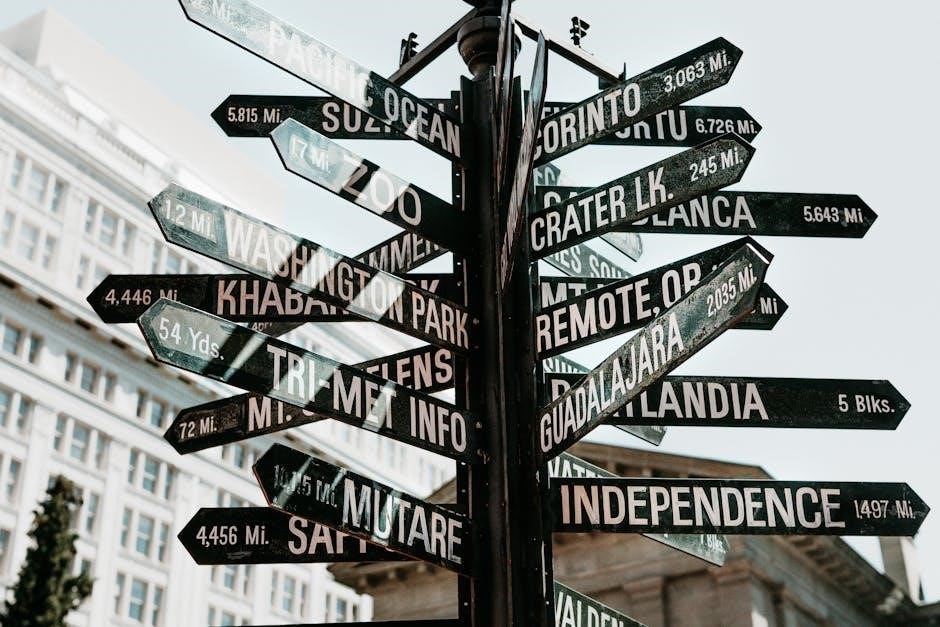Psilocybin mushrooms, known for their psychoactive properties, are found worldwide in diverse species. This guide provides comprehensive insights into their identification, historical significance, and modern applications, aiding enthusiasts and researchers alike.
1.1. Overview of Psilocybin Mushrooms
Psilocybin mushrooms are a diverse group of fungi containing psychoactive compounds like psilocybin and psilocin. With over 100 species worldwide, they belong primarily to the genus Psilocybe, though other genera like Copelandia and Panaeolus also produce psychoactive mushrooms. These fungi have been used historically in rituals and medicine, and modern research explores their therapeutic potential for mental health. Paul Stamets’ guide provides detailed descriptions and photographs, making it an invaluable resource for enthusiasts and researchers seeking to understand these fascinating organisms.
1.2. Historical and Cultural Significance
Psilocybin mushrooms have deep historical and cultural roots, particularly in Mesoamerica. The Aztecs and Mayans revered them as “flesh of the gods,” using them in spiritual rituals for divination and communion with deities. These fungi were considered sacred, often illustrated in ancient art and texts. Their use continued until the arrival of Spanish conquistadors, who suppressed their cultural practices. Today, they hold significance in modern psychedelic cultures and therapeutic exploration, bridging ancient traditions with contemporary interests and research.
1.3. Purpose of the Identification Guide
This guide aims to provide a comprehensive resource for identifying psilocybin mushrooms, enabling enthusiasts, researchers, and novices to recognize species accurately. By detailing key characteristics, habitats, and distribution, it helps users navigate the diverse world of these fungi. The guide also emphasizes safe handling, ethical considerations, and potential risks. Its purpose is to educate and promote responsible exploration, bridging the gap between scientific knowledge and cultural appreciation of these fascinating organisms.

Classification and Taxonomy
Classification and taxonomy offer a scientific framework for organizing psilocybin mushrooms, categorizing species into genera and families based on shared traits and evolutionary connections, essential for accurate identification and research.
2.1. Genera Containing Psilocybin
The primary genera containing psilocybin include Psilocybe, Panaeolus, and Copelandia. Psilocybe is the most diverse and widespread genus, with species like P. cubensis and P. semilanceata. Panaeolus species, such as P. cyanescens, are known for their smaller size and potent psychoactive compounds. Copelandia and Gymnopilus are less common but still significant contributors to the psilocybin-containing fungi. These genera are distinguished by unique physical and chemical traits, aiding in accurate identification and classification.
2.2. Species Diversity and Distribution
Psilocybin mushrooms exhibit remarkable species diversity, with over 200 known species worldwide. These fungi thrive in various habitats, from tropical forests to temperate grasslands. Psilocybe cubensis is widely distributed across tropical and subtropical regions, while Psilocybe semilanceata is common in Europe and North America. Certain species, like Psilocybe azurescens, are endemic to specific areas, such as the Pacific Northwest. Distribution patterns are influenced by climate, substrate, and geographic isolation, highlighting the adaptability of these mushrooms across different ecosystems.
2.3; Evolutionary Relationships
Psilocybin mushrooms belong to the family Hymenogastraceae, with most psychoactive species in the genus Psilocybe. Phylogenetic studies reveal that these fungi evolved from non-psychoactive ancestors, likely gaining the ability to produce psilocybin as an ecological adaptation. Molecular research suggests that Psilocybe species diverged from related genera around 50 million years ago. The evolution of psilocybin production may have provided a competitive advantage, such as deterring insect herbivory. This unique biochemical trait highlights their distinct evolutionary path within the Agaricales order.
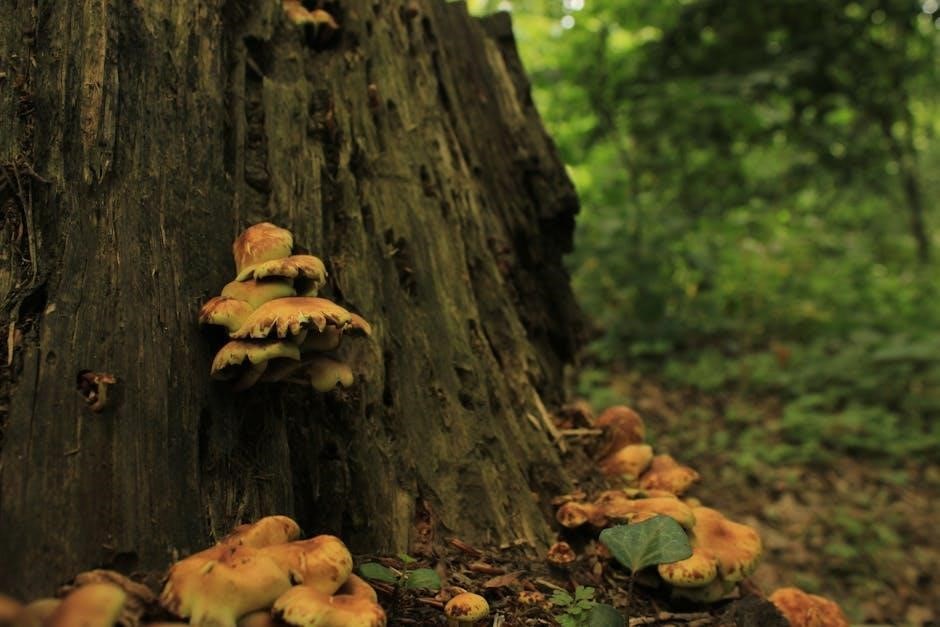
Distribution and Habitat
Psilocybin mushrooms are found worldwide, thriving in damp, humid environments, often near decaying wood or in grasslands. Tropical and temperate regions support diverse species, with specific substrates and microclimates shaping their habitats.
3.1. Global Distribution Patterns
Psilocybin mushrooms are found across the globe, with highest diversity in tropical and subtropical regions. They thrive in Central and South America, particularly in countries like Mexico and Brazil, where Psilocybe cubensis is common. North America, Europe, and Australia also host numerous species, with the Pacific Northwest being a hotspot for Psilocybe azurescens. Asia and Africa have endemic species, often in humid, forested areas. Their distribution is closely tied to specific substrates and microclimates, making them highly adaptable yet ecologically specialized.
3.2; Preferred Habitats and Growth Conditions
Psilocybin mushrooms thrive in diverse habitats, favoring moist, nutrient-rich environments. They commonly grow in forests, grasslands, and woodlands, often near decaying organic matter like wood, dung, or humus. Tropical and subtropical regions provide ideal conditions for many species, while others adapt to temperate climates. They typically require moderate humidity, shaded areas, and specific substrates to fruit. Seasonal rainfall and warm temperatures often trigger growth, with some species appearing in late summer or early fall. Understanding these conditions aids in successful foraging and cultivation.
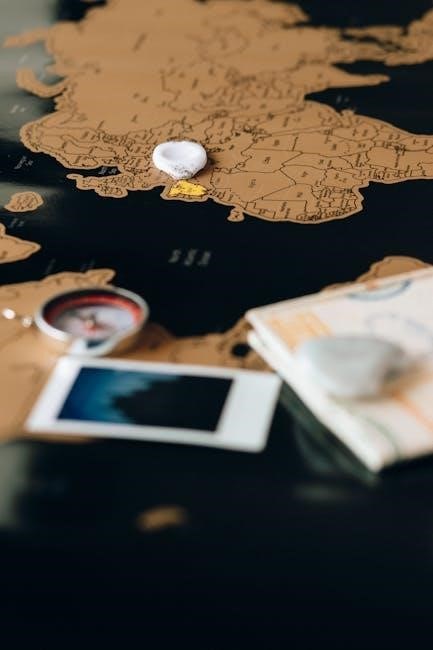
3.3. Regional Diversity in Species
Psilocybin mushrooms exhibit remarkable regional diversity, with species adapting to local ecosystems. Tropical regions like Central and South America host iconic species such as Psilocybe cubensis, while temperate areas in Europe and North America are home to Psilocybe semilanceata. The Pacific Northwest fosters unique species like Psilocybe azurescens, thriving in moist, coastal environments. Australia and Oceania harbor distinct varieties, including Copelandia and Panaeolus species. This diversity reflects varying climates, vegetation, and substrates, showcasing the mushrooms’ adaptability to different ecological niches worldwide.

Physical Identification Characteristics
Physical traits like cap shape, size, color, gill arrangement, stipe length, and veil presence are critical for identifying psilocybin mushrooms, varying significantly across species.
4.1. Cap Shape, Size, and Color
The cap of psilocybin mushrooms varies widely in shape, size, and color, offering key identification features. Species like Psilocybe cubensis have broad, rounded caps, often 1-8 cm in diameter, with colors ranging from light brown to golden. Others, such as Psilocybe semilanceata, exhibit smaller, conical caps with a pointed apex, typically reddish-brown to tan. Environmental factors and age can influence these traits, making observation of fresh specimens crucial for accurate identification. Some species display a metallic sheen or hygrophanous tendencies, changing color with moisture levels.
4.2. Gills, Stipe, and Veil Features
The gills of psilocybin mushrooms are typically attached to the stipe and vary in color, often darkening with spore maturity. The stipe, or stem, differs in size and shape among species, sometimes featuring a ring from the partial veil. This veil initially protects the gills before breaking away as the mushroom matures. Variations in veil prominence and stipe characteristics aid in species identification, with some displaying more robust features than others. Environmental factors can influence these traits, adding complexity to accurate classification.
4.3. Spore Print Analysis
Spore print analysis is crucial for identifying psilocybin mushrooms, as spore color and pattern are key taxonomic features. To create a spore print, place the mushroom cap on a glass slide or dark paper, cover it, and allow spores to deposit. Use a dropper to add water to hasten spore release. The resulting print’s color, ranging from purplish-brown to brown or yellowish, aids in species differentiation. This method, while valuable, should be combined with other characteristics for accurate identification, as spore color alone isn’t definitive. Proper equipment and patience ensure clear, interpretable results.
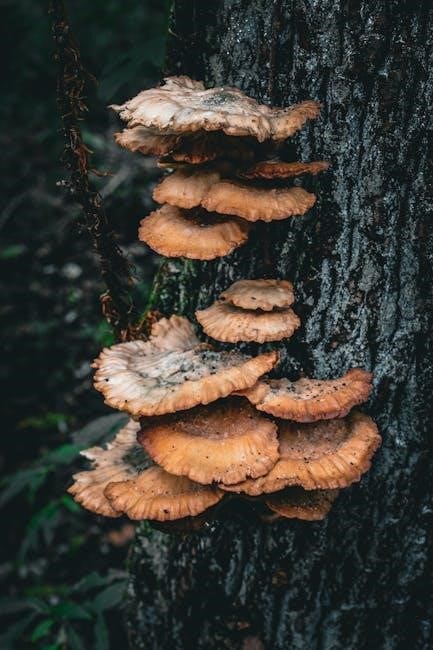
Chemical Composition and Potency
Psilocybin mushrooms contain psychoactive compounds like psilocybin and psilocin, which determine potency. Potency varies by species and environmental factors, influencing their effects and identification.
5.1. Psilocybin and Psilocin Content
Psilocybin mushrooms primarily contain psilocybin and psilocin, the main psychoactive compounds. Psilocybin is the predominant compound, converting to psilocin in the body. These alkaloids vary in concentration across species, with Psilocybe cubensis typically containing 0.5-1.5% psilocybin by dry weight, while Psilocybe semilanceata may have higher levels, up to 2%. Environmental factors like substrate and climate influence potency, making species-specific analysis essential for accurate identification and understanding their effects.
Testing methods, such as HPLC or chemical reagents, help quantify these compounds, aiding in species differentiation and potency assessment. This variability underscores the importance of precise identification for safe and informed use.
5.2. Factors Influencing Potency
Psilocybin and psilocin content varies significantly due to environmental and genetic factors. Substrate type, such as grass, dung, or wood, impacts alkaloid production. Climate conditions, like temperature and humidity, also influence potency. Genetic variability among species and even within the same species plays a role. Mushrooms harvested at different growth stages may exhibit varying concentrations. Additionally, geographical origin and seasonal fluctuations can affect chemical composition. These factors highlight the importance of precise identification and controlled environments for consistent potency levels in psilocybin mushrooms;
5.3. Testing and Detection Methods
Chemical testing is essential for identifying psilocybin and psilocin in mushrooms. The Ehrlich reagent test is commonly used for preliminary detection, turning blue when psilocybin is present. Thin-layer chromatography (TLC) and high-performance liquid chromatography (HPLC) provide more precise quantification. Mass spectrometry (MS) and infrared spectroscopy (IR) are advanced methods for confirming molecular structure. Portable devices like near-infrared (NIR) spectrometers are emerging for field testing. These methods ensure accurate identification and potency assessment, crucial for research, safety, and legal compliance. Professional lab analysis remains the gold standard for reliable results. Always prioritize precise testing to avoid misidentification dangers.

Key Species Profiles
This section highlights prominent psilocybin species, including Psilocybe cubensis, known for its widespread cultivation, and Psilocybe semilanceata (Liberty Cap), found in European fields. Panaeolus cyanescens thrives in diverse habitats, while Gymnopilus spectabilis offers vibrant colors but lower potency. Each species exhibits unique traits, essential for accurate identification and appreciation of their ecological roles.
6.1. Psilocybe cubensis
Psilocybe cubensis, commonly known as the “Magic Mushroom,” is one of the most widely recognized and cultivated psilocybin species. It typically features a rounded to bell-shaped cap, measuring 1-8 cm in diameter, with a golden-brown to light-brown color. The gills are sinusoid, crowded, and initially pale, turning darker as spores mature. The stipe is thick, white, and can grow up to 12 cm tall. Native to subtropical regions, it thrives in humid environments, often growing in grassy areas or dung. Potency varies, but it contains both psilocybin and psilocin, making it highly sought after for its psychoactive effects. Its ease of cultivation and widespread distribution have contributed to its popularity among enthusiasts and researchers alike.
6.2. Psilocybe semilanceata (Liberty Cap)
Psilocybe semilanceata, or the Liberty Cap, is a small, potent species native to Europe and North America. It features a conical to bell-shaped cap, typically 0.5-2 cm in diameter, with a tan to brown color. The gills are narrow, crowded, and initially pale, darkening with age. The stipe is slender, fibrous, and light-colored. Found in grassy areas, often in fields with livestock, it prefers fertile, alkaline soils. The spore print is dark brown, a key identifier. Known for its high psilocybin content, it is highly sought after by enthusiasts and researchers for its potent psychoactive effects.
6.3. Psilocybe azurescens and Other Pacific Northwest Species
Psilocybe azurescens is a highly potent species native to the Pacific Northwest, known for its striking blue-green hue when bruised. It thrives in sandy, coastal areas, often near alder trees. The cap is conical to convex, typically 3-10 cm in diameter, with a wavy margin. The stipe is fibrous and pale. This species is prized for its strong psychoactive properties. Other regional species, like Psilocybe ovoideocystidiata and Psilocybe subfagioluta, also exhibit unique characteristics, making the Pacific Northwest a hotspot for diverse psilocybin mushrooms with distinct habitats and potencies.
6.4. Copelandia and Panaeolus Species
Copelandia and Panaeolus are genera of psilocybin mushrooms known for their unique characteristics. Copelandia, often called “Copes,” are highly potent and typically grow in tropical or subtropical regions. They are recognized by their small to medium-sized caps, often with a rounded or conical shape. Panaeolus species, while less psychoactive, are widespread and diverse, with some producing psilocybin. Both genera are notable for their growth on dung or rich organic matter, though their potencies and habitats vary significantly.
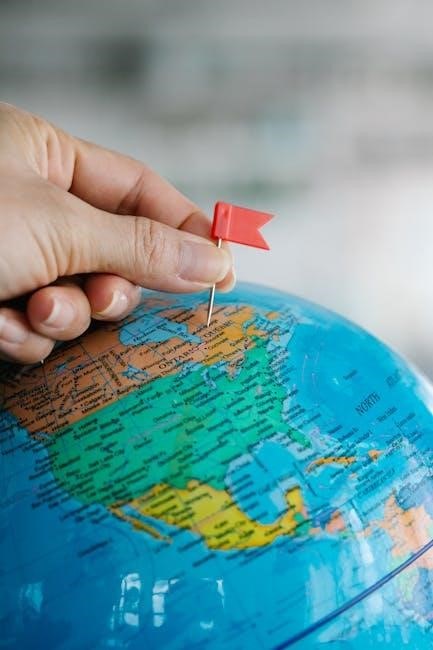
Cultural and Historical Use
Psilocybin mushrooms have been integral to ancient Mesoamerican cultures, used in spiritual and medicinal practices. Considered sacred, they played roles in rituals and ceremonies. Their influence extends to art and philosophy, reflecting deep cultural significance. Despite historical reverence, their use was often prohibited in the 20th century, though modern research has reignited interest.
7.1. Indigenous Use in Mesoamerica
Psilocybin mushrooms have been sacred in Mesoamerican cultures for millennia, particularly among the Aztecs and Mayans. They were revered as “teonanocatl” or “flesh of the gods,” used in spiritual rituals, divination, and healing ceremonies. Indigenous shamans employed them to communicate with deities, guide spiritual journeys, and resolve community conflicts. These practices highlight their deep cultural and spiritual significance, reflecting a profound connection to nature and the divine.
7.2. Role in Traditional Medicine and Rituals
Psilocybin mushrooms have long been integral to traditional medicine and rituals across various cultures. In many indigenous societies, they were used for healing, spiritual purification, and divination. Shamans employed them to diagnose illnesses, communicate with ancestors, and guide spiritual journeys. Ceremonies often involved ritualistic consumption to promote healing, harmony, and community bonding. These practices underscore their revered status as a bridge between the physical and spiritual realms.
7.3. Modern Therapeutic Applications
Recent studies have revived interest in psilocybin’s therapeutic potential. Clinical trials suggest efficacy in treating treatment-resistant depression, anxiety, and PTSD. Research institutions like Johns Hopkins have documented significant reductions in symptoms after controlled doses. Psylocybin-assisted therapy shows promise for addiction recovery and endangered mental health conditions. These findings are paving the way for potential medical approvals, marking a new era in psychedelic-based healing.
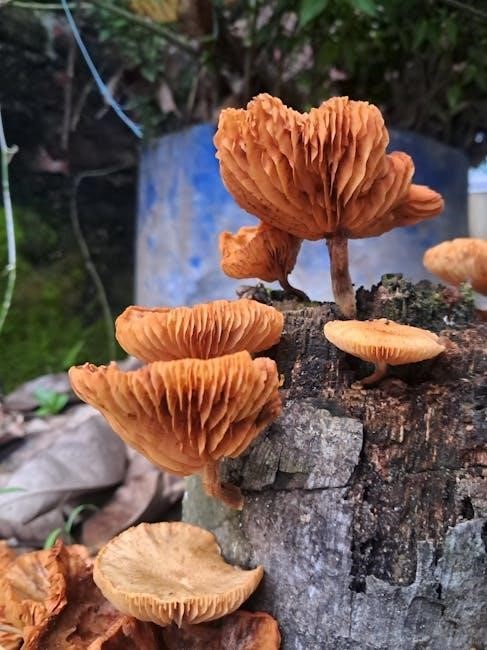
Legal Status and Ethical Considerations
Psilocybin mushrooms are illegal in most countries under UN drug conventions, but legal status varies. Some regions have decriminalized possession, while others permit medical use. Ethical concerns include sustainable harvesting and responsible use to avoid exploitation.
8.1. Global Legal Status Overview
Psilocybin mushrooms are classified as Schedule I substances under UN drug conventions, making them illegal in most countries. However, some regions, like parts of the Americas, have decriminalized possession in small quantities. Medical and therapeutic use is gaining acceptance, with countries such as Australia and Canada allowing controlled access. Legal frameworks vary widely, reflecting cultural and regulatory differences. Ethical considerations emphasize responsible use and sustainable practices to avoid over-harvesting wild species.
8.2. Ethical Sourcing and Sustainability
Ethical sourcing involves responsible harvesting of wild psilocybin mushrooms to avoid over-harvesting and protect ecosystems. Many species grow in sensitive habitats, requiring careful extraction to preserve biodiversity. Sustainable practices include avoiding over-collection and respecting local regulations. Cultivation is increasingly promoted as an eco-friendly alternative, reducing pressure on wild populations. Ethical considerations also extend to respecting indigenous communities and ensuring equitable access to benefits from these species. Balancing conservation with therapeutic use is crucial for long-term sustainability.
8.3. Risks and Responsibilities
Handling psilocybin mushrooms carries inherent risks, including misidentification, which can lead to accidental ingestion of toxic species. Users must ensure proper identification to avoid health complications. Additionally, there are legal risks, as possession and use are regulated in many regions. Responsibilities include adhering to local laws, practicing safe consumption, and sourcing ethically to protect both individuals and ecosystems. Proper education and caution are essential to mitigate these risks responsibly.
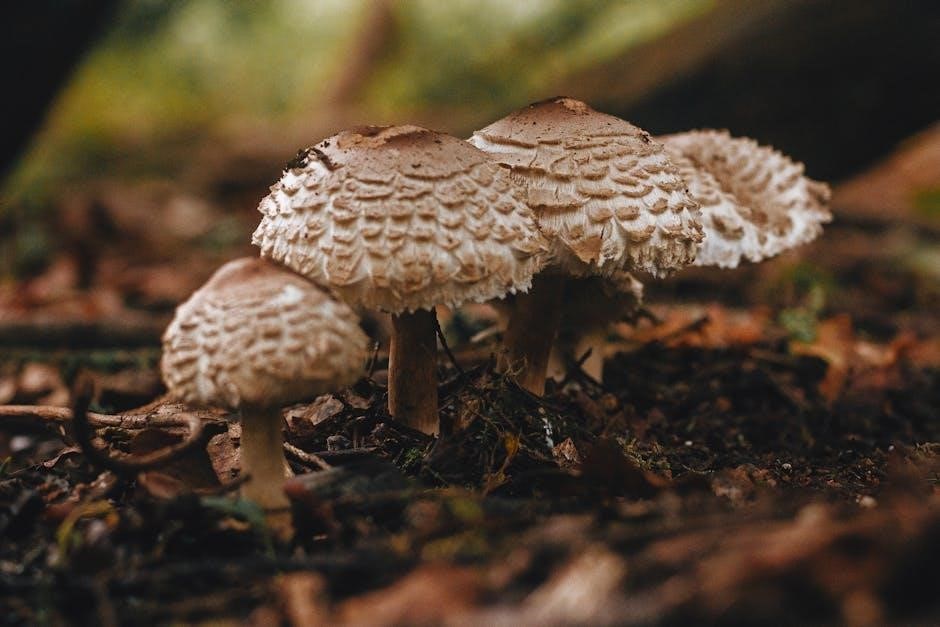
Safety and Risks
Misidentification poses serious health risks, as some species are toxic. Proper knowledge and caution are essential to ensure safe handling and consumption of psilocybin mushrooms.
9.1. Potential Health Risks
Psilocybin mushrooms can cause adverse reactions, including nausea, vomiting, and increased heart rate. Psychological effects may include anxiety, paranoia, or psychosis, particularly in high doses.
Seizures and other complications are rare but possible, especially in individuals with pre-existing medical conditions. Individual tolerance and sensitivity vary widely, emphasizing the need for cautious use.
Accidental ingestion of toxic lookalike species poses severe health risks, including organ failure. Proper identification and a controlled environment are critical to mitigate these dangers effectively.
9.2. Lookalike Species and Misidentification Dangers
Misidentification of psilocybin mushrooms is a critical issue due to the presence of lookalike species that can be poisonous. Some mushrooms resemble psilocybin species but contain toxins that can cause severe health complications. The dangers of misidentification include accidental poisoning, which can lead to organ damage or even death. Proper identification requires extensive knowledge and experience, emphasizing the importance of expert-level mushroom identification to avoid these risks. Always exercise extreme caution when foraging for wild mushrooms to prevent such dangerous outcomes.
9.3. Safe Handling and Consumption Practices
When handling psilocybin mushrooms, prioritize hygiene to prevent contamination. Clean mushrooms thoroughly with a damp cloth or brush, avoiding water absorption. Use gloves to minimize direct contact. For consumption, ensure proper identification and dose measurement. Start with a small amount to assess sensitivity. Consume in a safe, controlled environment with a trusted person present. Avoid mixing with alcohol or other substances. Be aware of legal and health risks, and consult medical advice if necessary. Proper preparation and mindset are essential for a safe experience.
This guide provides a comprehensive overview of psilocybin mushrooms, emphasizing identification, safety, and cultural significance. Future research may expand therapeutic applications and conservation efforts, fostering responsible exploration.
10.1. Summary of Key Points
Psilocybin mushrooms are fascinating organisms with rich cultural and historical significance. This guide provides an in-depth look at their classification, distribution, and identification features. It covers their role in traditional medicine and modern therapeutic applications, emphasizing safety and ethical considerations. Proper identification and responsible handling are crucial to mitigate risks. As research progresses, these mushrooms may offer new medical breakthroughs, highlighting the importance of conservation and sustainable practices. Understanding and respecting these organisms can lead to a brighter future for both humans and the environment.
10.2. Emerging Research and Developments
Recent studies on psilocybin mushrooms highlight their potential in mental health treatment, with clinical trials showing promise for conditions like depression and PTSD. Advances in cultivation techniques and genetic research are improving understanding of species diversity. Innovations in testing methods, such as portable chemical analysis tools, enhance safety and identification. Additionally, researchers are exploring the role of psilocybin in neuroplasticity and creativity, opening new avenues for therapeutic applications. These developments underscore the importance of ethical practices and sustainable sourcing in this rapidly evolving field.
10.3. Final Thoughts on Conservation and Exploration
Conservation of psilocybin mushrooms is crucial to preserve their ecological roles and potential benefits. Over-harvesting and habitat destruction threaten species, emphasizing the need for sustainable practices. Ethical exploration and research should prioritize environmental protection and respect indigenous knowledge. Collaboration between scientists, conservationists, and policymakers is vital to balance discovery with preservation. By fostering responsible stewardship, we ensure these fungi continue to inspire scientific and cultural advancements while safeguarding their place in nature for future generations.
